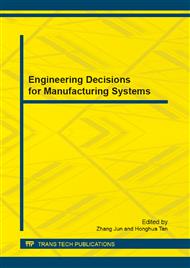[1]
Raptis Ioannis A, Valavanis Kimon P and Moreno Wilfrido A, A novel nonlinear backstepping controller design for helicopters using the rotation matrix, IEEE Transactions on Control Systems Technology, vol. 19, no. 2, pp.465-473, (2011).
DOI: 10.1109/tcst.2010.2042450
Google Scholar
[2]
Fuyang Chen, Wenli Luan and Rui Hou, A self-repairing control for the uncertain system of a helicopter using adaptive sliding mode technology, Advanced Materials Research, vol. 468-471, pp.529-533, (2012).
DOI: 10.4028/www.scientific.net/amr.468-471.529
Google Scholar
[3]
Fuyang Chen, Bin Jiang and Gang Tao, A self-repairing control scheme for the helicopter via adaptive sliding mode back-stepping technology, IFAC Proceedings Volumes (IFAC-Papers Online), vol. 8, pp.788-793, (2012).
DOI: 10.3182/20120829-3-mx-2028.00215
Google Scholar
[4]
Wang H, Peng Y and Wu W Q, Yaw angle control channel of subminiature unmanned helicopter based on ADRC, Frontiers of Manufacturing Science and Measuring Technology II, vol. 503-504, pp.1527-1531, (2012).
DOI: 10.4028/www.scientific.net/amr.503-504.1527
Google Scholar
[5]
Sun L, Wang R, Sun J and Zhang H, Subsystem disturbance rejection control of turbo-shaft engine/helicopter based on cascade ADRC, Journal of Beijing University of Aeronautics and Astronautics, vol. 37, no. 10, pp.1312-1316, (2011).
Google Scholar
[6]
Jiang Z, Active disturbance rejection control for the yaw tracking for unmanned helicopter, Proceedings of the World Congress on Intelligent Control and Automation (WCICA), pp.1915-1919, (2012).
DOI: 10.1109/wcica.2012.6358189
Google Scholar
[7]
Zhang Haibo, Wang Jiankang, Chen Guoqiang, Yan Changkai, A new hybrid control scheme for an integrated helicopter and engine system, Chinese Journal of Aeronautics, vol. 25, no. 4, pp.533-545, (2012).
DOI: 10.1016/s1000-9361(11)60417-2
Google Scholar
[8]
Liu Xiang, Li Donghai, Jiang Xuezhi and Hu Xuejiao, Simulation study on auto-disturbance-rejection control for unstable systems and non-minimum phase systems, Kongzhi yu Juece/Control and Decision, vol. 16, no. 4, pp.420-424+429, (2001).
DOI: 10.1109/wcica.2006.1714341
Google Scholar
[9]
Liu Huanye, Research and design of flight control system for small four rotor aircraft[D], Shanghai Jiao Tong University, (2009).
Google Scholar
[10]
Han J, The active disturbance rejection controller and its application, Control and Decision, vol. 13, no. 1, pp.19-23, (1998).
Google Scholar
[11]
Han J, ADRC control technology-the control technology of state estimation and disturbance compensation[M], National Defense Industry Press, Beijing, (2008).
Google Scholar
[12]
3-DOF Hover-User and Laboratory Manual.
Google Scholar


